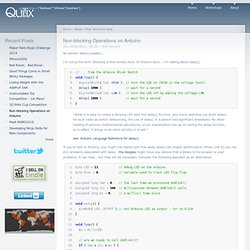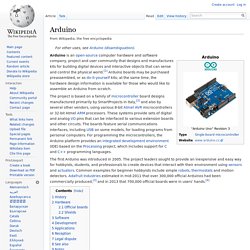

Top 5 Chip-Sized Arduino Compatible Boards.
UP Board (Intel) UP board 4GB RAM + 64 GB eMMC - UP Board. Microcontroller Basics - Introduction. One thing is great about microcontroller ICs, these are available almost in all parts of the globe and electronic retailers.

Fundamentally microcontroller devices are popularly used in applications involving assessments of the surrounding environment and in similar electronics. You could find these devices being used for displaying a certain parameter, in motor control applications, LED lighting, sensors of various types such tilt sensor, accelerometer, velocity meter, data loggers, temperature controllers, keyboards etc. The primary understanding regarding microcontrollers could be obtained by referring to AVR Amega32 microcontroller which is so advanced that sometimes it’s called a computer within a chip. This device is assigned to carry out series of commands to form a program. The language of the program that you would be seeing here is C++. When it comes to MCUs, you get the facility of having the option of controlling and configuring all of its pinouts. Electronic and Educational Toys.
What is I/O Expander? Input and output pins are very precious resources in small digital projects these days.

Popular small micro controllers like the PIC, 8051, SX, BASIC Stamp, etc., may only have 8-to-16 lines of I/O available for use, while we typically have a need to drive LCD displays, LEDs and frequency synthesizers; and read A/D converters, keyboards, shaft encoders and more. Hardware interfacing is the name of the game, and you can never have too much I/O capability on a processor to handle all these tasks. I/O Expander. Expand I/O capabilities of small homebrew projects with"IOX" .. an I/O Expander Serial LCD + Frequency Counter + driver for A/D Converter, Keypad and Digital Potentiometer IOX SOURCE CODE | HOST SOURCE CODE (EXAMPLE) | Photo of IOX on Eval Board The IOX chip works great with the QuickieLab project board OVERVIEW The I/O Expander is a 28-pin SX microcontroller that is programmed to operate as a slave I/O processor to a host controller in your projects.

IOX interfaces peripheral components (LCD, A/D Converter, digital pot, and matrix keypad) to the host processor over a conventional asynchronous serial line. ChipKIT from Microchip - Developed for the Ardu... All Places > Design Center > Documents The chipKIT™ platform is an intuitive prototyping solution that enables students, educators and hobbyists from a variety of disciplines to introduce intelligent electronics into their project without understanding microcontroller (MCU) architecture.

Whether new to embedded systems or looking to upgrade exisitng Arduino-based projects, users can now enjoy the increased performance, added memory space and advanced peripherals. Products Back to Top Discussions Back to Top. Non-blocking Operations on Arduino. No stinkin' library needed....

I'm using the term 'blocking' a little loosely here.
PMOD. MIT App Inventor/Google App Inventor. IOIO - Control Devices with Android. Iteaduino and Cubieboard. Intel Atom Minnowboard. FreeSOC drag and drop build. Breakout board. Bare OPEN PCB. MC HCK The $5 versatile board. Reverse engineering Apple's secret charging methods. Index of - BASIC Commands. Device on Chip. Xylotex x86. All Categories - APC Forum. List of 39 Low Cost Linux Friendly Boards and Products. Dmitry (omgfire), one of my awesome readers, compiled a great tabular list of Linux friendly boards and products that sells for less than $300 US (usually less than $200). This list includes technical details such as the processor, GPU, memory, NAND flash, connectivity, ports, supported Linux distributions… as well as availability and pricing information. There are currently 39 Linux devices in total.
Wandboard. Odroid-X. Flashboard. ARM IC's TI. Keith & Koep GmbH - SPARK Your Imagination. Keith & Koep GmbH - Products: Baseboards, modules, Evaluation-Kits. Gumstix. Platino. Pinguino. Olimex. Programing. Microcontrollers. Small Computers. Industrial control,scada,hmi,domotic DATALOG. Arduino. Arduino Buying Guide. Arduino Buying Guide Let’s face it, there are a a lot of different Arduino boards out there.

How do you decide which one you need for your project? With this table, you can not only compare features between all the different Arduino boards we carry, but you can also see why these differences are important. What is an Arduino? Let’s first talk about what an Arduino really is. All Arduino boards have one thing in common: they are programmed through the Arduino IDE. Why are they different? Some boards are designed to be embedded and have no programming interface (hardware) which you would need to buy separately. 1The miniUSB connector on the Arduino Fio is used for battery charging only. 2The LilyPad Simple Board does have one UART but the pins aren't broken out to pads. *The Arduino Leonardo has the same GPIO pin-count as the other “Uno” style boards but more of the pins play “double duty” as both analog and digital pins, thus the higher numbers. Glossary of Terms:
Home energy data logging project. Yesterday I saw that onterio will be increasing the electric bills 46% over the next 5 years as they phase out coal and go renewable.

We don't have coal to phase out but are expecting similar increases in the future. The city recently announced millions in water infrastructure updates and they will be billing that not through property taxes but on water usage. In both cases the more you use the worse the hit will be. So today I decided it's time to get off my *** and get really serious about consumption logging and reduction. We've done pretty good on the electric front but more can be done I'm sure. Spartan 3E Breakout and Development Board. Playground - Java. Arduino. Arduino is an open-source computer hardware and software company, project and user community that designs and manufactures kits for building digital devices and interactive objects that can sense and control the physical world.[1] Arduino boards may be purchased preassembled, or as do-it-yourself kits; at the same time, the hardware design information is available for those who would like to assemble an Arduino from scratch.

The first Arduino was introduced in 2005. USB + Serial Backpack Kit with 16x2 RGB backlight negative LCD [RGB on Black] ID: 784 - $24.95 : Adafruit Industries. Adding a character display to your project or computer has never been easier with the new Adafruit USB or TTL serial backpack!
![USB + Serial Backpack Kit with 16x2 RGB backlight negative LCD [RGB on Black] ID: 784 - $24.95 : Adafruit Industries](http://cdn.pearltrees.com/s/pic/th/industries-electronics-37048292)
This custom-designed PCB sits on the back of our 'standard' character LCD (16x2 or 20x4 sized) and does everything you could want: printing text, automatic scrolling, setting the backlight, adjusting contrast, making custom characters, turning on and off the cursor, etc. It can even handle our RGB backlight LCDs with full 8-bit PWM control of the backlight. That means you can change the background color to anything you want - red, green, blue, pink, white, purple yellow, teal, salmon, chartreuse, or just leave it off for a neutral background. Inside the backpack is an USB-capable AT90USB162 chip that listens for commands both a mini-B USB port and a TTL serial input wire. The USB interface shows up as a COM/serial port on Windows/Mac/Linux. A new open source hardware project every month. Arduino and DS18B20 - 1-wire digital thermometer.
Finally got this DS18B20 working.

Actually three of them. And in two modes. Parasite power mode and main mode. A 4.7K ohm resistor is the key. Starting with the main mode, three wires are needed, as this sensor has three pins. Works with three wires, as seen on the following illustration. Parasite mode eliminates one wire. Maybe following illustration helps. FTDI Basic Breakout - 5V. Description: This is the newest revision of our FTDI Basic. We now use a SMD 6-pin header on the bottom, which makes it smaller and more compact. Functionality has remained the same. This is a basic breakout board for the FTDI FT232RL USB to serial IC.
Fritzing. Small PCB design/manufacture.